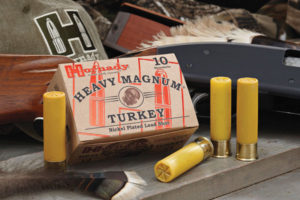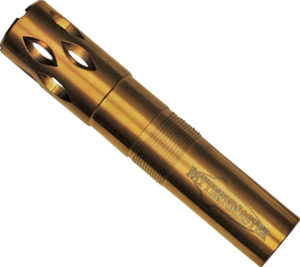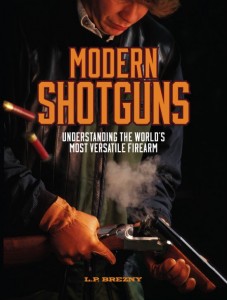

Critical aspects of bringing home a long beard happen way before the start of turkey season. Testing to discover the maximum range of your gun and the most effective combination of choke and loads are preseason musts.
Killing turkeys at longer distances is possible with today’s plethora of ammunition and choke tubes. A critical factor, of course, is the hunter’s personal ethic and comfortable kill zone. For some, that’s within 30 yards. For others, it might be farther. That’s part of the hunting process we have to decide and must live with.
Maximizing long-range efficiency with your shotgun and ammunition requires trial and error at the range.
Ammunition and choke tubes are expensive, so combining efforts with fellow hunters is a good way to spend time learning about which setup works best for you. Three or four hunters chipping in, bringing chokes and ammo and spending a few hours patterning loads is paramount to discovering what works best so you’ll be comfortable in the woods.
“At 40 or 50 steps, or any range for that matter, I want to get 10 hits in the kill zone of a life-size turkey head target with an even pattern that surrounds it,” said Brandon Wallace, a 33-year-old Alabama hunter and founder of Wallace Custom Calls. He’s chased turkeys for two decades.
“It only takes one hit in the bone of a turkey head to put it down for the count. Lots of guns and loads do this at 30 yards, and many will also do it farther. Everyone likes the holy grail of 300 pellets in a 10-inch circle, which is awesome, but it takes a special load, choke and lots of range time to do it.”
Know Your Limitations
Wallace noted that, “Some guns might be 30-yard guns, and some might be 50 and beyond,” which is why range time is so critical. Clark Bush, founder of AllAboutShooting.com, has spent hundreds of hours at the range testing chokes, shotguns and ammunition through the years, and he agreed that knowing your setup’s efficiency — and limitations — makes all the difference.
“I buy butcher paper by the rolls and spend a lot of time at the range,” Bush said. “I shoot everyone’s chokes, guns and ammo. There’s no way to know how a gun patterns until you’re at the range.
“I’m not into numbers (of pellets) as much as I want to see a good, even core density within a 10-inch circle at 40 yards, or a 14-inch halo around it and good density. It’s not subjective. If it has a gap in it of more than 2 inches, I don’t find that acceptable. The problem I see with that is (hunters) pattern these in the middle of summer, and we hunt mostly in spring and autumn. Those patterns are affected greatly by ambient temperature and density.”
Time or financial constraints might keep hunters from getting to the range several times a year in various seasons. But Bush believes it’s necessary to shoot in different seasons and weather conditions to truly discover what your gun and ammunition can do.
Turkey hunters dream of gorgeous spring days, warm temperatures and sunny skies. But the reality is we might have a late winter, hotter-than-normal temperatures or a late cold front that blows in. If you have only patterned your gun in summer, those cold temperatures could alter the dynamic of the shot pattern.
Pick The Right Choke
Mark Bansner spent years designing and refining choke tubes for hunters and competitive shooters, working in thousandths of degrees of constriction to create maximum downrange patterns.
Today, Bansner is out of the choke business and instead focuses on designing custom rifles from his company headquarters in Pennsylvania. He’s applying his knowledge of shotguns and accuracy to rifles, and believes turkey hunters can do the same to maximize their success.
“I think the No. 1 thing is to have a gun with a barrel that’s 24 inches long,” Bansner said. “I think that’s the optimal length for a shotgun barrel. Shotgun powders burn extremely quick and are exhausted by the time the shot column gets to about 22 or 23 inches. Anything longer than that actually slows it down. I proved that more than 25 years ago by cutting barrels in 1-inch increments and chronographing it.
“After hundreds of rounds, I determined … there’s no real difference between 18 and 24 inches, but 21 to 24 inches is perfect. From a power and velocity standpoint, the barrel should be 21 to 24 inches. From a patterning standpoint, in the old days, copper-coated was king, and I was an advocate of using a larger pellet. But with today’s alloy loads and heavier loads, like tungsten polymers, their No. 5 shot is equivalent of the penetrating qualities of No. 4 lead.”
Wallace noted the Nitro combos, such as the 5-by-6-by-7, and other turkey loads today are combinations of different shot sized or souped-up polymers. Some turkey hunters stick with lead pellets — for tradition, finances or both — as their top performer. Whatever the load, Bansner said matching the choke tube to the ammo is keenly important to get the best results.
“Pellet size is critical,” Bansner said. “You might shoot 6s or 7s and get 40 or more pellets in the head (area), but you might not be doing anything with them if the energy isn’t there. Knowing the limitation of your gun is important. Once you figure that out, the choke systems today, and even the ones we were producing years ago, will help.”
Editor's note, this article appeared in the 2014 Turkey and Turkey Hunting‘s Equipment Guide.
Recommended Resources
Gun Digest Guide to Modern Shotgunning


![Best Concealed Carry Guns In 2025 [Field Tested] Wilson Combat EDC X9S 1](https://gundigest.com/wp-content/uploads/Wilson-Combat-EDC-X9S-1-324x160.jpg)


![Best 9mm Carbine: Affordable PCCs [Tested] Ruger Carbine Shooting](https://gundigest.com/wp-content/uploads/Ruger-Carbine-Shooting-100x70.jpg)
![Best AR-15: Top Options Available Today [Field Tested] Harrington and Richardson PSA XM177E2 feature](https://gundigest.com/wp-content/uploads/Harrington-and-Richardson-PSA-XM177E2-feature-100x70.jpg)
